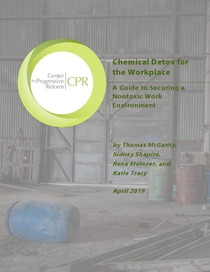Chemical detox for the workplace: a guide to securing a nontoxic work environment
"An estimated 50,000 lives are cut short every year in the United States - an average of 137 deaths a day - because of occupational diseases. Most of these deaths result from toxic chemical exposures on the job. Based on this estimate, an individual is more likely to die from a fatal illness ac...
| Main Authors: | , , , |
|---|---|
| Institution: | ETUI-European Trade Union Institute |
| Format: | TEXT |
| Language: | English |
| Published: |
Washington, DC
2019
CPR |
| Subjects: | |
| Online Access: | https://www.labourline.org/KENTIKA-19307409124911256819-Chemical-detox-for-the-workpla.htm |
| Summary: | "An estimated 50,000 lives are cut short every year in the United States - an average of 137 deaths a day - because of occupational diseases. Most of these deaths result from toxic chemical exposures on the job. Based on this estimate, an individual is more likely to die from a fatal illness acquired at work than from an opioid overdose, a firearm incident, or a motor vehicle crash. The true death toll from occupational illness is likely higher than estimated because government statistics are incomplete.
Inadequately regulated chemical hazards are at their deadliest in the workplace. People exposed to toxics at work tend to encounter dangerous substances more frequently, for longer durations, and at higher levels than the public at large. Workers are at substantial risk across dozens of sectors including agriculture, domestic cleaning, hair and nail salons, home repairs, building construction, and chemical manufacturing. ...
This guide is intended to assist workers and worker representatives with finding information on chemical hazards and then utilizing that information to achieve a nontoxic workplace. Although this guide does not cover every issue or situation workers may face, it is our hope that it will assist with identifying the appropriate questions to ask, initiating research on chemicals of concern in the workplace, and collaborating with other workers, unions, and local organizers to take action.
Section One provides a list of tactics worker advocates can employ to reduce toxic risks and assist injured workers.
Section Two gives readers a basic overview of the federal laws applicable to toxic chemicals. While the Occupational Safety and Health Act covers many workplaces, it does not apply everywhere. Further, depending on the industry, environmental laws may provide remedies for exposed workers. Other laws, regulations, contracts, or agreements may — and likely do — govern in specific states and specific workplaces. Before taking any action, additional background research and consultation with worker advocates, university professors, citizen groups, and others in a community or nearby states is recommended.
Section Three specifies the best resources available to help identify chemical hazard information and take action to reduce chemical hazards in the workplace." |
|---|---|
| Physical Description: | 49 p. Digital |

